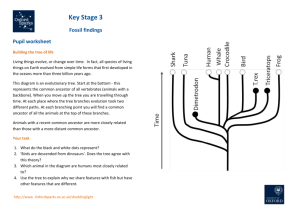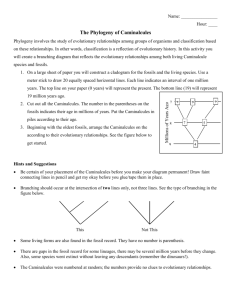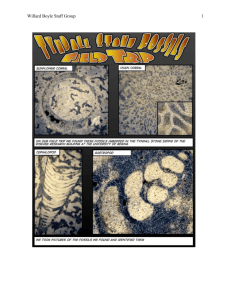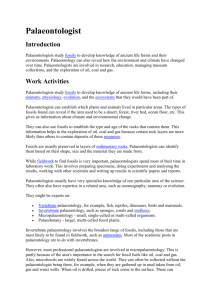KS3_Fossil_findings_Teachers_Notes
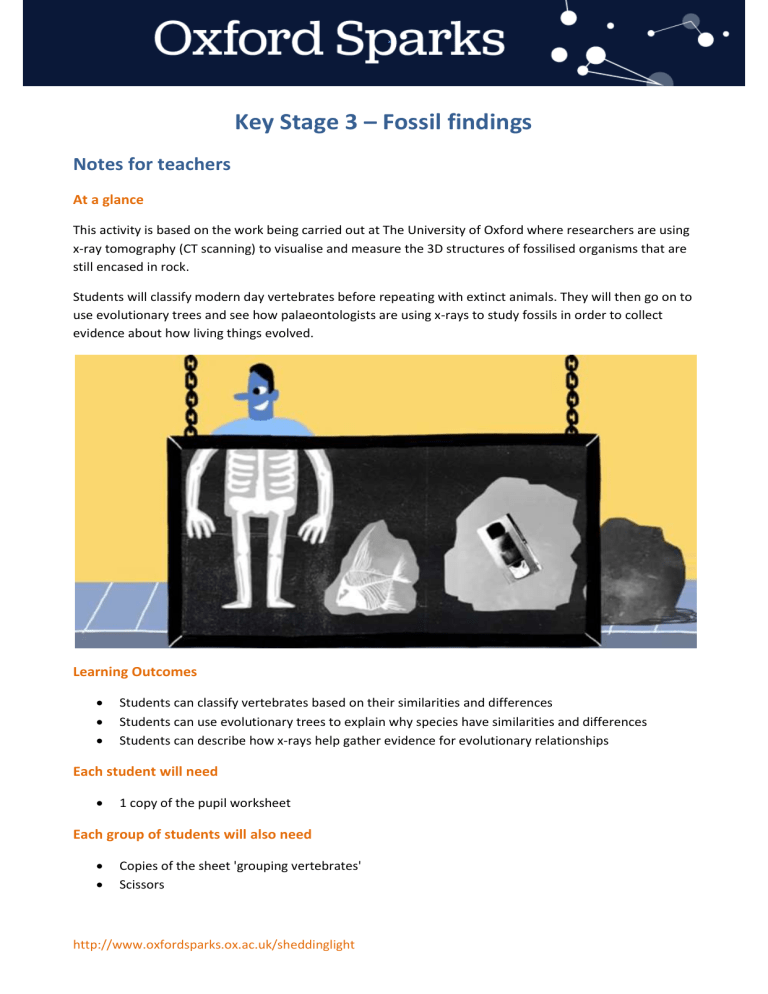
Key Stage 3 – Fossil findings
Notes for teachers
At a glance
This activity is based on the work being carried out at The University of Oxford where researchers are using x-ray tomography (CT scanning) to visualise and measure the 3D structures of fossilised organisms that are still encased in rock.
Students will classify modern day vertebrates before repeating with extinct animals. They will then go on to use evolutionary trees and see how palaeontologists are using x-rays to study fossils in order to collect evidence about how living things evolved.
Learning Outcomes
Students can classify vertebrates based on their similarities and differences
Students can use evolutionary trees to explain why species have similarities and differences
Students can describe how x-rays help gather evidence for evolutionary relationships
Each student will need
1 copy of the pupil worksheet
Each group of students will also need
Copies of the sheet 'grouping vertebrates'
Scissors http://www.oxfordsparks.ox.ac.uk/sheddinglight
Possible Lesson Activities
1.
Starter activity
Tell the class that they are related to fish! Show them images of the external and internal features of fish (or you could even demonstrate a fish dissection). Ask them to work in pairs or small groups and write down some similarities and differences between humans and fish.
Discuss what they have found out. Ask the class to suggest why we have some common features. They may already have some ideas about evolution and common ancestors.
2.
Main activity: Grouping animals
Supply small groups with page 1 of the 'grouping vertebrates' sheet. Ask them to suggest what all these animals have in common (they have a backbone).
They then should cut out the cards and put them into groups of their choosing. Remind them that they should be looking at similarities and differences and group animals that share similar features. If students already have good knowledge of vertebrate groups then after they have grouped the animals into their vertebrate groups (mammals, fish, reptiles, birds and amphibians) give them page 2 which contains some other examples which are more difficult to classify. Let groups study each other's groupings so they can compare the different methods used to sort them.
Now, provide groups with the extinct animals from page 3. Ask them to put these animals into their existing groups. They should find this more difficult as these animals are the ancestors of the modern-day animals and so could share features with more than one group. Discuss with the class why this was more difficult.
Formally introduce the concept that modern-day animals have evolved from these ancient ancestors. Give students page 1 of the pupil worksheet for them to read through. You may have to explain the concept of evolutionary trees in more detail. Some suitable resources can be found in the 'weblinks' section below.
Students then answer the questions on the sheet to check their understanding. Discuss the answers, paying particular attention to question 4 which returns to the starter activity.
Answers:
1.
The black dots show extinct animals, the white dots are animals that are still living.
2.
Birds and T.rex have a common ancestor so we can say that birds evolved from a group of early dinosaurs.
3.
Whales - they share a recent common ancestor. Both are mammals.
4.
We share a common ancestor with fish so share some features (e.g. skeleton with backbone, eyes, mouth). However, this was a long time ago so fish and humans have evolved different features.
3.
Main activity: Using x-rays
Show the animation ‘Shedding Light on the Situation' to the class which outlines a range of research projects being carried out at The University of Oxford.
Supply students with page 2 of the pupil worksheet which explains the work using x-rays to study fossils in more detail. You can supply them with further information about CT scanning using the weblinks below. Students complete the task. http://www.oxfordsparks.ox.ac.uk/sheddinglight
Link back to the grouping animals task by discussing with the students why in reality classifying extinct animals is more difficult than the task they did with the images and why.
Palaeontologists only have fossils to study - not images like they did! In fact, how accurate do they think the images they used are? Also, you might like to discuss with the class that phylogeny and taxonomy are now largely done via genetic studies and that this is not possible with most extinct organisms because there is no DNA to sequence.
4.
Plenary
Ask students to discuss in pairs if they think evolutionary trees ever change and why. The answer is yes! Just like all scientific theories, they will change depending on evidence.
Further information: How do we look at fossils trapped in rocks?
Dr Matt Friedman
Fossils preserve unique information about the form and evolutionary relationships of long-extinct species.
More often than not, these key clues are enveloped in surrounding rock. Traditionally this encasing sediment would be chipped away with tools, a laborious, time-consuming process that risked damaging rare fossil specimens and would still leave the innermost aspects of anatomy concealed.
Early approaches to obtaining as much information as possible on fossil structure used a technique that ground away wafer-thin sections of the fossil, revealing a series of cross-sections that could be turned into a physical model of the specimen. Although this approach yields great detail, it carries a substantial drawback: the fossil itself would be ground to dust.
Palaeontologists today harness the power of light to do something similar, but instead of physically slicing up their precious fossils they do so virtually using X-ray computed tomography. Called CT for short, this approach is more familiar as a medical tool for looking inside of patients and exploits the fact that X-rays travel more easily through some materials than others. Palaeontologists use special CT scanners that offer much higher resolution than medical machines in order to tease out details of even tiny fossil samples. CT scanning permits an analysis of ancient anatomy in a way never before possible, as fossil specimens can be
‘virtually dissected’ on a computer. Resulting models can be shared between researchers as electronic files, helping to promote international collaboration. Physical copies of these models can even be produced at a range of magnifications with 3D printing, permitting researchers and students to handle and inspect fossils that might be too big, too small, or too fragile to handle.
Weblinks http://datadryad.org/resource/doi:10.5061/dryad.6j13r
Supplemental data 3 is a 3D animation of the endocast shown in the pupil worksheet. http://evolution.berkeley.edu/evolibrary/article/phylogenetics_02
Further information on how to read evolutionary trees http://www.digimorph.org/
Extensive online repository of CT scans of fossils and living creatures http://www.oxfordsparks.ox.ac.uk/sheddinglight
http://www.nhm.ac.uk/research-curation/science-facilities/analytical-imaging/imaging/computedtomography/micro-ct/
CT scanner at the NHM, London, showing the range of objects that can be studied using this approach http://www.oxfordsparks.ox.ac.uk/sheddinglight
